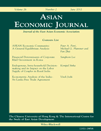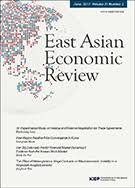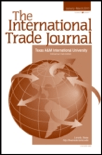
Asian Economic Journal
Scope & Guideline
Illuminating the Path to Regional Economic Growth
Introduction
Aims and Scopes
- Regional Economic Analysis:
The journal emphasizes empirical and theoretical analyses of economic phenomena within Asian countries, focusing on issues like trade, investment, and economic policy. - Interdisciplinary Approaches:
It encourages research that integrates economics with other disciplines such as sociology, political science, and environmental studies, reflecting the complex interactions in economic decision-making. - Policy-Oriented Research:
The journal aims to contribute to policy discussions by publishing studies that provide insights into the effectiveness of economic policies in the Asian context. - Dynamic Economic Models:
Utilization of advanced econometric and dynamic modeling techniques to analyze economic data and forecast trends is a hallmark of the research published in this journal. - Social and Economic Inequality:
Research addressing income inequality, social mobility, and demographic changes in the context of economic development is a significant focus area, highlighting issues of equity and access.
Trending and Emerging
- Impact of Digital Technologies:
There is an increasing focus on the economic implications of digital technologies, such as their effects on productivity and market structures, reflecting the rapid digital transformation in Asian economies. - Post-Pandemic Economic Recovery:
Research addressing the economic aftermath of COVID-19, including recovery strategies and policy effectiveness, has surged, demonstrating the journal's engagement with timely global issues. - Environmental Economics and Sustainability:
Emerging themes around environmental sustainability, climate change impacts, and economic policies addressing these challenges are gaining traction, indicating a shift towards integrating economic and environmental considerations. - Gender and Economic Inequality:
Studies exploring gender disparities in economic opportunities and outcomes are increasingly prevalent, highlighting a growing awareness of social issues within economic research. - International Trade Dynamics:
The journal has expanded its coverage of international trade relationships, particularly in the context of geopolitical shifts and new trade agreements, reflecting the complexities of global economic interactions.
Declining or Waning
- Traditional Labor Economics:
Research centered around traditional labor economics concepts such as wage determination and labor market structures has decreased, possibly due to a shift toward more dynamic and interdisciplinary approaches. - Macroeconomic Stability Focus:
Papers primarily focused on macroeconomic stability indicators, such as inflation rates and GDP growth, have become less frequent, indicating a possible shift towards microeconomic and sector-specific analyses. - Basic Economic Theory Applications:
The application of basic economic theories without empirical backing has waned, as there is a growing emphasis on data-driven research that utilizes advanced methodologies.
Similar Journals

Pacific Economic Review
Innovating Solutions through Interdisciplinary Research.Pacific Economic Review, published by WILEY, is a prestigious academic journal dedicated to the exploration of economic issues within the Pacific region, including interdisciplinary perspectives across Aerospace Engineering, Development, and Geography, Planning, and Development. With its ISSN 1361-374X and E-ISSN 1468-0106, this journal has established itself as a crucial platform for disseminating high-quality research, evident in its categorization in Q2 across multiple fields for 2023. Researchers and professionals aiming to contribute to the understanding of economic dynamics—especially those affecting the Pacific context—will find this journal an invaluable resource. Even without open access options, the journal provides extensive insights through its articles and has a commendable ranking in Scopus, ranked #329/716 in the Economics and Econometrics category, placing it in the 54th percentile. Through the convergence of knowledge from diverse fields from its inception in 1996 to the present, the Pacific Economic Review serves as a vital conduit for scholarly dialogue and innovative solutions to economic challenges.

Korean Economic Review
Enriching the discourse on Korean and global economics.Korean Economic Review is a distinguished academic journal published by the Korean Economic Association, dedicated to advancing the field of economics with a focus on both theoretical and empirical research. With an ISSN of 0254-3737, this journal serves as a vital platform for scholars and practitioners to disseminate innovative ideas and findings that enrich our understanding of economic phenomena. Operating in South Korea, the journal enjoys recognition within the academic community as evidenced by its Q3 ranking in the Economics, Econometrics and Finance categories as of 2023, placing it in a respectable position among its peers. While it does not currently offer open access options, its commitment to rigorous peer review ensures the publication of high-quality research. As the journal converges from 2012 to 2024, it continues to contribute to the global discourse on economic issues, making it an essential resource for researchers, students, and professionals striving to stay at the forefront of economic scholarship.

Malaysian Journal of Economic Studies
Driving Scholarly Excellence in Economic StudiesMalaysian Journal of Economic Studies is a prominent peer-reviewed academic journal dedicated to advancing the field of economics, econometrics, and finance. Published by PERSATUAN EKONOMI MALAYSIA, this journal has been a vital platform for scholarly research since its inception, with a publication history spanning from 2007 to 2024. With an impressive Q3 quartile rank in the Economics, Econometrics, and Finance category and a Scopus ranking that places it in the 44th percentile among its peers, the journal serves as a critical conduit for disseminating innovative economic research and findings that can inform policy-making and academic discourse. Although it currently does not offer Open Access, it remains committed to enhancing the visibility of economic research in Malaysia and beyond. Scholars, practitioners, and students alike will find this journal a valuable resource that not only reflects the evolving economic landscape but also contributes to a deeper understanding of economic phenomena on a global scale.

Quantitative Economics
Unlocking the future of economics with data-driven analysis.Quantitative Economics is a leading open-access journal published by WILEY, dedicated to advancing the field of economics through rigorous quantitative analysis. Established in 2010 and based in the United States, this influential journal boasts an impressive Q1 rating in the 2023 category of Economics and Econometrics, reflecting its high impact and quality within the field. With a Scopus ranking of #222 out of 716 in the Economics and Econometrics category, it sits comfortably in the 68th percentile, underscoring its relevance to researchers and professionals alike. The journal accepts a wide range of submissions, including original research articles, methodological advancements, and comprehensive reviews, which contribute to the understanding and application of quantitative methods in economic research. By providing immediate open access to all published articles, Quantitative Economics ensures that vital findings are readily available to academics, policymakers, and students across the globe, enhancing collaboration and innovation within the discipline.

Asian Economic Papers
Unveiling insights into the dynamics of Asian economies.Asian Economic Papers, published by MIT Press, is a premier academic journal that delivers cutting-edge research in the dynamic fields of economics and political science with a specific focus on Asian economies. Since its inception in 2008, the journal has carved out a significant niche, reflected in its impressive 2023 Scopus Rankings; including a Q1 categorization in Political Science and International Relations, and Q2 rankings in both Economics and Finance. With a rigorous peer-review process, it aims to foster scholarly discourse on economic policies, practices, and research relevant to Asian contexts. Although not an open-access journal, it presents a valuable contribution to the academic landscape, making it indispensable for researchers, professionals, and students seeking insightful analysis and data-driven studies. Based in Cambridge, MA, Asian Economic Papers holds a notable reputation for its high-impact output and continues to be pivotal in shaping economic thought and policy in Asia and beyond.

Asian Journal of Applied Economics
Fostering Knowledge Exchange in Applied EconomicsAsian Journal of Applied Economics is a prestigious academic journal published by Kasetsart University, Faculty of Economics, dedicated to advancing the field of applied economics within the Asian context. With a strong commitment to open access, this journal ensures that vital research is accessible to a diverse audience, fostering knowledge exchange among researchers, professionals, and students. The journal covers a broad spectrum of topics related to applied economic theories, practical applications, and policy implications pertinent to Asia, making it an essential resource for those involved in economic research and analysis. Although specific metrics such as the impact factor and H-index are currently unavailable, the journal's reputation within the field continues to grow, underpinned by a robust editorial board and thorough peer-review processes. Researchers are encouraged to submit their work to contribute to the evolving discourse in applied economics, thereby influencing both academic and practical efforts in this crucial area of study.

Global & Local Economic Review
Illuminating the Path of Economic Research and CollaborationGlobal & Local Economic Review is a prestigious journal published by EDIZIONI TRACCE, dedicated to advancing the field of economic studies at both global and local levels. With the ISSN 1722-4241 and E-ISSN 1974-5125, this journal serves as a crucial platform for researchers, professionals, and students seeking to explore the complexities and interdependencies within economic systems. Although the journal currently does not provide open access, it is committed to disseminating high-quality, peer-reviewed research that addresses pressing economic challenges. With a focus on promoting innovative ideas and practices, the Global & Local Economic Review fosters scholarly dialogue and collaboration among economists and policymakers worldwide, helping to shape the future of economic research. Its contributions are pivotal in helping stakeholders understand both macroeconomic trends and local economic phenomena, ensuring its relevance in an ever-evolving economic landscape. For further information, the journal can be contacted at its address: VIA EUGENIA RAVASCO 54, PESCARA 65123, ITALY.

East Asian Economic Review
Advancing Knowledge on East Asian Economic Trends.East Asian Economic Review is a premier academic journal dedicated to the multifaceted exploration of economic issues and developments in East Asia. Published by the Korea Institute for International Economic Policy, this journal serves as a vital platform for researchers, practitioners, and policymakers interested in the region's economic dynamics. Since transitioning to Open Access in 2013, it has enhanced accessibility, allowing for a broader dissemination of knowledge and fostering collaborative research. While the journal currently does not have an impact factor rating, its commitment to high-quality research continues to attract contributions that significantly advance the understanding of economic policies, trade relations, and market trends in East Asia. The East Asian Economic Review stands out as an essential resource for anyone involved in or studying the intricate economic landscape of one of the world's most dynamic regions.

CESifo Economic Studies
Empowering Research to Shape Economic FuturesCESifo Economic Studies, published by Oxford University Press, is a distinguished academic journal that focuses on the interdisciplinary exploration of economics and its implications on society. With an ISSN of 1610-241X and an E-ISSN of 1612-7501, the journal aims to disseminate high-quality research that contributes to the advancement of economic knowledge, particularly emphasizing empirical findings and innovative theoretical frameworks. As a recognized leader in its field, CESifo Economic Studies holds a 2023 Q2 ranking in both Economics and Econometrics and Geography, Planning and Development, reflecting its significant impact and relevance in these areas. The journal is accessible through traditional subscription models, ensuring that critical economic research remains available to scholars, policymakers, and educators alike. With a commitment to excellence in publication, the journal supports the academic community through the provision of rigorous peer-reviewed articles that address current challenges and trends in economics. Researchers and students seeking to deepen their understanding of economic mechanisms will find this journal an invaluable resource.

International Trade Journal
Shaping policies through rigorous research.The International Trade Journal, published by Taylor & Francis Ltd, is a vital resource in the field of international trade, economics, and business management. Established in 1986, this journal offers a platform for rigorous empirical and theoretical research, focusing on the dynamics of global trade and its implications on economic and international policy. With an ISSN of 0885-3908 and an E-ISSN of 1521-0545, it serves as a valuable reference for scholars and practitioners alike. The journal is ranked in the Q3 category for Economics, Econometrics and Finance, signifying its role in disseminating high-quality research. Although it currently does not offer Open Access, the journal's wealth of insights supports researchers and professionals in navigating the complexities of international trade while shaping informed policies. With convergence from 1986 to 2024, the International Trade Journal continues to be an essential tool for fostering knowledge and understanding within this increasingly interconnected global economy.